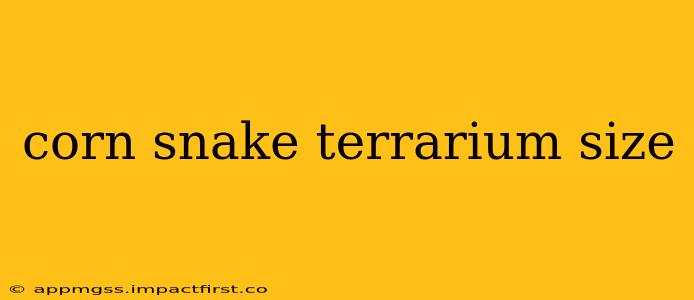Choosing the right terrarium size for your corn snake is crucial for their health and well-being. A cramped enclosure can lead to stress, while one that's too large can make it difficult to maintain proper humidity and temperature gradients. This guide will help you determine the ideal size, considering your snake's age and future growth.
What Size Terrarium Does a Corn Snake Need?
The general rule of thumb is that a corn snake's enclosure should be at least twice as long as the snake's body length. This provides ample space for movement, exploration, and natural behaviors. However, the specifics depend heavily on the snake's age:
-
Baby Corn Snakes (Under 1 Year): A 10-gallon tank is generally sufficient for a young corn snake. This offers enough space for them to grow comfortably without feeling overwhelmed. Ensure it has appropriate hides and climbing structures proportional to their small size.
-
Juvenile Corn Snakes (1-2 Years): As your snake grows, you'll need to upgrade to a larger enclosure. A 20-gallon long tank is a good option at this stage. The extra length allows for more exploration and helps maintain temperature gradients.
-
Adult Corn Snakes (2+ Years): Adult corn snakes are typically around 3-4 feet long. They'll thrive in a 40-gallon breeder tank or a similar-sized enclosure. Remember, longer is better than taller, as corn snakes are primarily terrestrial.
What are the Minimum and Maximum Terrarium Sizes?
While the size recommendations above offer a good starting point, it's vital to avoid both minimum and maximum extremes.
Minimum Size: Anything smaller than the recommended sizes will likely restrict your snake's natural behaviors, impacting its overall health and potentially leading to stress. Cramped spaces can also make maintaining optimal environmental conditions difficult.
Maximum Size: While it might seem beneficial to give your snake an enormous enclosure, this isn't always ideal. Extremely large terrariums can make it challenging to regulate temperature and humidity, potentially creating "cold spots" or excessively dry areas that can negatively affect your corn snake's health. Additionally, larger enclosures require more substrate, potentially increasing cleaning frequency and costs.
What Shape of Terrarium is Best for a Corn Snake?
While size is paramount, the shape of the enclosure also matters. Horizontal tanks (longer than they are tall) are significantly better than vertical tanks for corn snakes. This reflects their terrestrial nature—they spend most of their time on the ground rather than climbing. A long tank allows for better space utilization and easier establishment of thermal gradients.
How Much Space Does a Corn Snake Need to Thrive?
Thriving doesn't just mean surviving; it involves allowing your corn snake to exhibit natural behaviors. The correct enclosure size provides the space for:
-
Exploration: Adequate space enables your corn snake to explore its environment, satisfying its innate curiosity.
-
Hiding: Multiple hides, both wet and dry, are crucial to allow your snake to regulate its temperature and feel secure.
-
Basking: Your corn snake needs access to a basking spot with a warmer temperature gradient.
What if My Corn Snake is Still Growing?
Regularly assess your snake's size and compare it to the length of its enclosure. If your snake is beginning to outgrow its current home, plan for an upgrade to a larger terrarium before it becomes cramped. This prevents sudden changes that can stress the snake. A gradual transition to a larger enclosure is preferable.
By following these guidelines, you can provide your corn snake with a comfortable and enriching habitat that supports its health and happiness. Remember to always prioritize your corn snake's well-being when selecting a terrarium.
